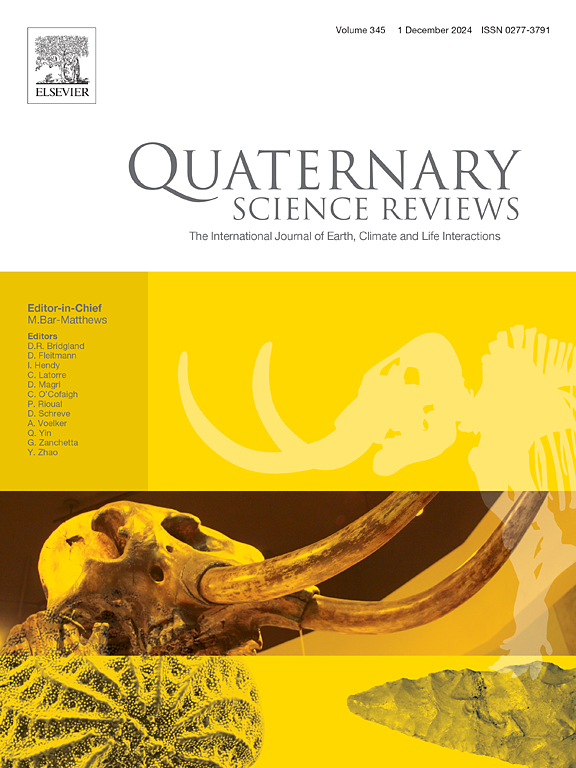中国南方第四纪陡齿龙-亚罗波达动物群的变异:上普布洞(广西布兵盆地)
IF 3.2
1区 地球科学
Q1 GEOGRAPHY, PHYSICAL
引用次数: 0
摘要
石龙子动物群是中国南方第四纪动物群的代表。然而,越来越清楚的是,该动物群内部存在着巨大的变异。在此,我们报告了来自中国南方广西步兵盆地上蒲洞的一个新的第四纪晚期动物群。上蒲洞是石龙-小龙动物群变异的一个很好的例子,尤其是在更广泛的步兵盆地第四纪动物群序列中。对上普布进行了两次发掘,共发现 2396 件哺乳动物化石,其中大部分是中型到大型动物的孤立牙齿。已确认的 24 个哺乳动物类群是石齿兽-兽脚类动物群(Stegodon-Ailuropoda Faunal Complex)的代表,包括兽脚类(Ailuropoda)、石齿兽(Stegodon)、庞戈类(Pongo)、犀牛类(Rhinoceros)、貘类(Tapirus)和象鼻类(Elephas)。通过铀系列、电子自旋共振(ESR)和光激发发光(OSL)方法,上普布的年代为 210-100 ka。上普布化石的主要年代为海洋同位素阶段("MIS")6。鉴于中更新世第六期气候的恶劣性,上普布灵长类和食肉类动物的数量和比例的减少可能是中更新世("Chibanian")末期环境恶化和森林面积减少的结果。我们有理由推测,在中更新世末期,华南地区出现了以森林为主的、类似马赛克的栖息地--这是该地区第四纪环境变化的一个很好的例子。本文章由计算机程序翻译,如有差异,请以英文原文为准。
Variation in the Quaternary Stegodon-Ailuropoda Faunal Complex in Southern China: Upper Pubu Cave (Bubing Basin, Guangxi)
The Stegodon-Ailuropoda Faunal Complex is representative of Quaternary faunas across southern China. However, it is becoming increasingly clear that a great deal of variation is present within the faunal complex. Here we report a new late Quaternary faunal assemblage from Upper Pubu Cave, Bubing Basin, Guangxi, southern China. Upper Pubu is a good example of the variation in the Stegodon-Ailuropoda Faunal Complex, particularly when situated in the broader Bubing Basin Quaternary faunal sequence. Upper Pubu was excavated two times resulting in the discovery of 2396 mammalian fossils, consisting mostly of isolated teeth from medium- to large-sized animals. Twenty four mammalian taxa were identified, representative of the Stegodon-Ailuropoda Faunal Complex, including Ailuropoda, Stegodon, Pongo, Rhinoceros, Tapirus, and Elephas. Upper Pubu is dated to 210–100 ka by Uranium-series, electron spin resonance (ESR) and optically stimulated luminescence (OSL) methods. The Upper Pubu fossils largely date to Marine Isotope Stage (“MIS”) 6. Given the severity of the climate during MIS 6, the reduction in both the number and proportion of primates and carnivores in Upper Pubu may be the result of environmental deterioration and a decrease in forested areas towards the end of the Middle Pleistocene (“Chibanian”). It is reasonable to speculate that a predominantly forested and mosaic-like habitat was present during the end of the Middle Pleistocene in southern China – a good example of environmental change during the Quaternary in the region.
求助全文
通过发布文献求助,成功后即可免费获取论文全文。
去求助
来源期刊

Quaternary Science Reviews
地学-地球科学综合
CiteScore
7.50
自引率
15.00%
发文量
388
审稿时长
3 months
期刊介绍:
Quaternary Science Reviews caters for all aspects of Quaternary science, and includes, for example, geology, geomorphology, geography, archaeology, soil science, palaeobotany, palaeontology, palaeoclimatology and the full range of applicable dating methods. The dividing line between what constitutes the review paper and one which contains new original data is not easy to establish, so QSR also publishes papers with new data especially if these perform a review function. All the Quaternary sciences are changing rapidly and subject to re-evaluation as the pace of discovery quickens; thus the diverse but comprehensive role of Quaternary Science Reviews keeps readers abreast of the wider issues relating to new developments in the field.
 求助内容:
求助内容: 应助结果提醒方式:
应助结果提醒方式:


